July 18, 2014
The second stop on my golf trip to England was at Royal Birkdale Golf Club. It was relatively close to Hoylake where the Open Championship was being hosted and made for a good round before attending the Open Championship on Saturday and Sunday. I had a mid-morning tee time so headed out early since I didn't know what traffic would be like, and I also wanted to make sure I had plenty of time to explore the clubhouse and grounds, warm up and stretch at the practice facility, and felt comfortable at the beginning of my round.
I was very excited to play Royal Birkdale due to its extensive and historic past, playing host to nine men's Open Championships, six women's Open Championships, and two Ryder Cups.
Royal Birkdale appears numerous times throughout The World's 500 Greatest Golf Holes and receives quite a few accolades. Among them are:
- Holes 12 and 18 are listed as two of the top 100 holes in the world.
- Hole 12 is listed as one of the top 20 par 3s in all of the United Kingdom.
- Hole 18 is listed as one of the top 20 par 4s in all of the United Kingdom.
- Hole 15 is listed as one of the top 20 par 5s in all of the United Kingdom.
- Hole 18 is listed as one of the 18 best holes with bunkers in the world.
- Hole 12 is listed as one of the 18 best links holes in the world.
- Hole 18 is listed as one of the 18 holes in the world that has produced one of the greatest moments in golf history (Nicklaus concedes Jacklin a 3 foot putt in the 1969 Ryder Cup for the first ever between the U.S. and Great Britain halve of that tournament).
I knew going out that it was going to be a heck of a tough test for my game, especially since it had hosted the women's Open Championship the previous weekend. But, I also know it would be a good experience with the course in immaculate condition, as well as showing me what the best in the world have to face. What I didn't expect was the course to play even tougher due to a 25-30 mph sustained wind throughout the overcast day. I guess it was time to experience British golf at its best! There are three sets of tees at Royal Birkdale - white, yellow, and red. Due to the weather and the course set up to host an Open Championship, we decided to play from the middle tees that plays 6,381 yards, 500 yards shorter than the white tees.
 |
| A look at the clubhouse from the trail to the practice facility. |
 |
| The flag bearing the coat of arms for Royal Birkdale. |
 |
| Starter hut seated neatly beside the first tee box. |
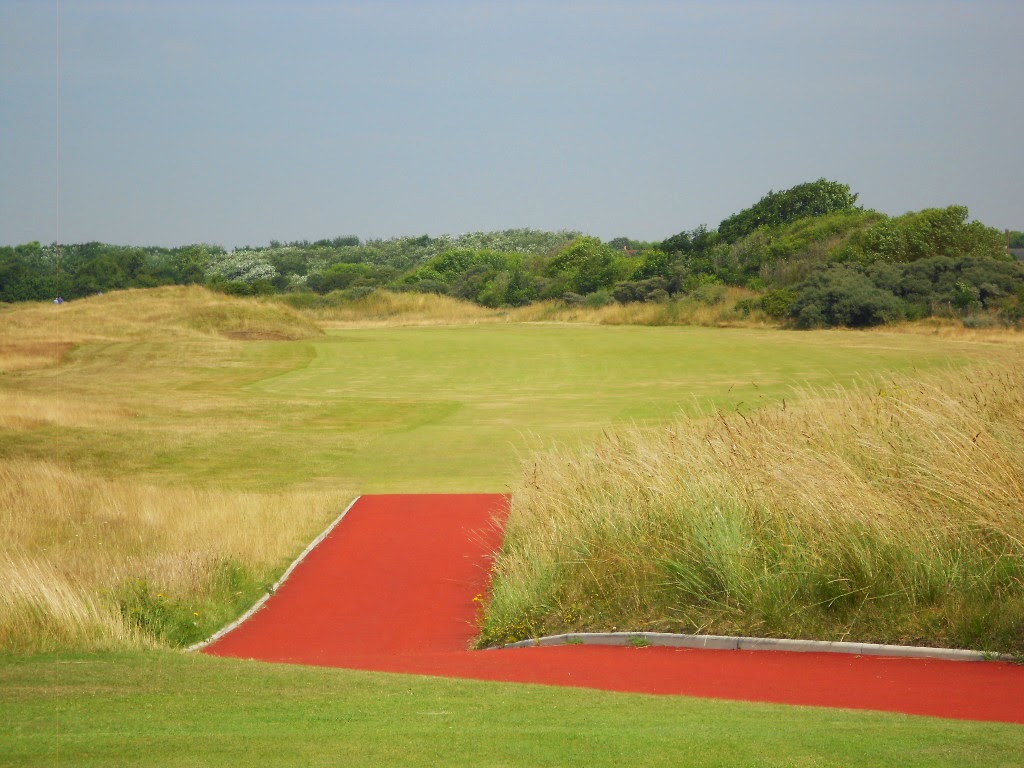 |
| A look down the fairway from the 1st tee box. |
The first hole, sometimes rated as one of the most difficult holes on the course, is a 430 yard par 4. It is often described as the toughest opening hole for an Open Championship course.
 |
| A look towards the green from the turn of the dogleg. |
The fairway starts a left dogleg at 230 yards so it is likely that you should consider using a 3 wood off the tee instead of a driver.
 |
| A look into the 1st green from 150 yards out. |
 |
| A look into the 1st green from 60 yards out. |
The green slopes front to back so your best option is usually a bump and run up on to the green. Caution should be taken to avoid the three bunkers that are on the front edge of the green.
 |
| A look onto the 1st green from the right side. |
 |
| A look down the fairway from the 2nd tee box. |
The second hole is a shorter par 4 that plays to 397 yards. It is a slight dog leg left that plays into the prevailing wind. There are two bunkers on the right of the fairway. However, they will only come into play for long hitters as the front edge of the first is 302 yards from the tee.
 |
| A look into the 2nd green from 140 yards out. |
The green is well protected by the bunkers and rough banks. There are five bunkers located on the edge of the green, and a much larger bunker that sits in the center of the fairway, 10-15 yards in front of the green. The photo below shows just how strong the wind was on this day as the flag is blowing hard to the right.
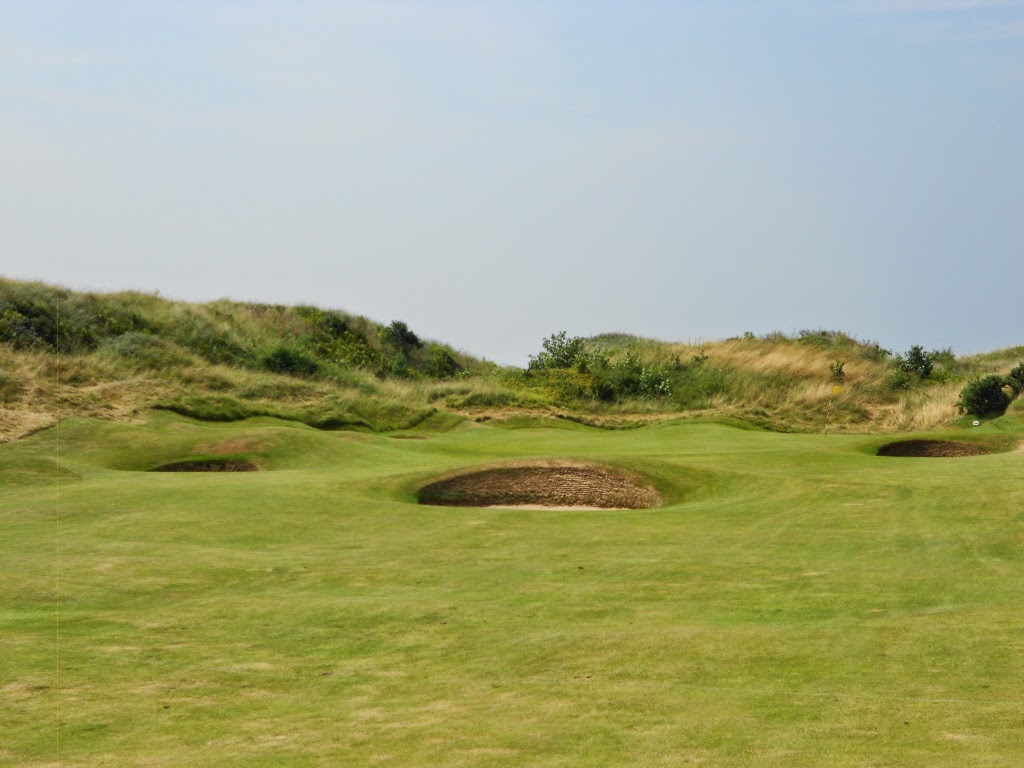 |
| A look into the 2nd green from 50 yards out. |
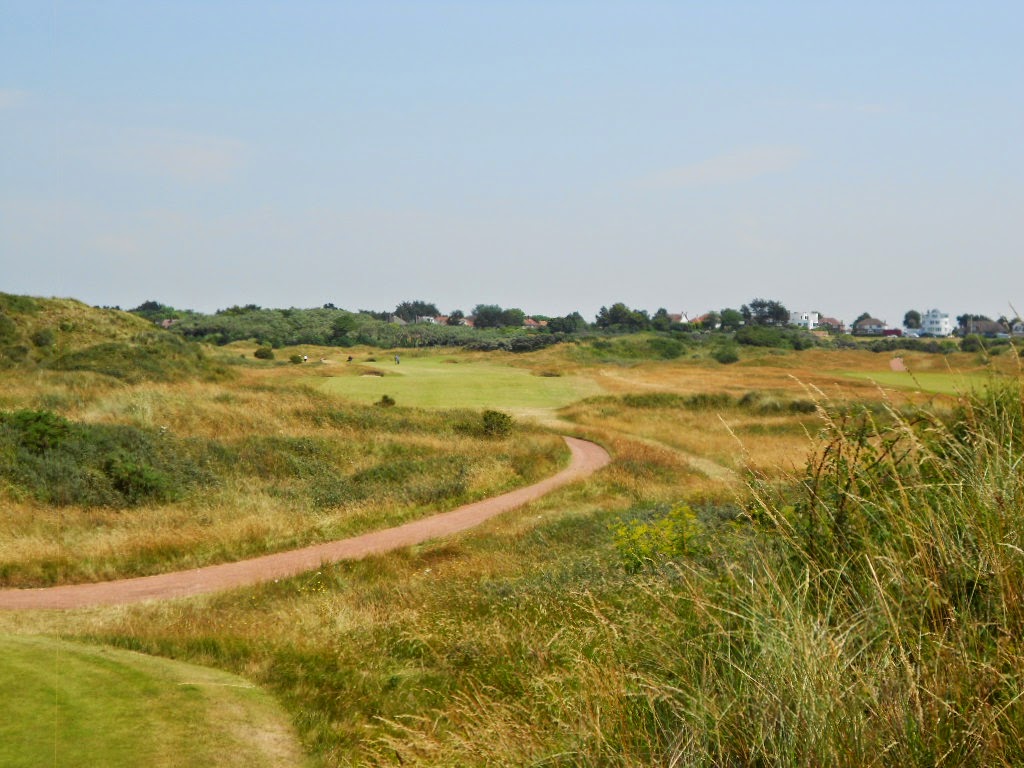 |
| A look down the fairway from the 3rd tee box. |
The third is an even shorter par 4 playing to 373 yards. The drive needs to favor the left side of the fairway to give a clear second shot to the green. There are two bunkers on the left side of the fairway, however, they are just over 300 yards out so only come into play if you are a long driver.
 |
| A look into the 3rd green from 140 yards out. |
The green is protected by a couple of bunkers. The rough across the course, especially on this hole, is extremely difficult to hit out of and should be avoided at all costs.
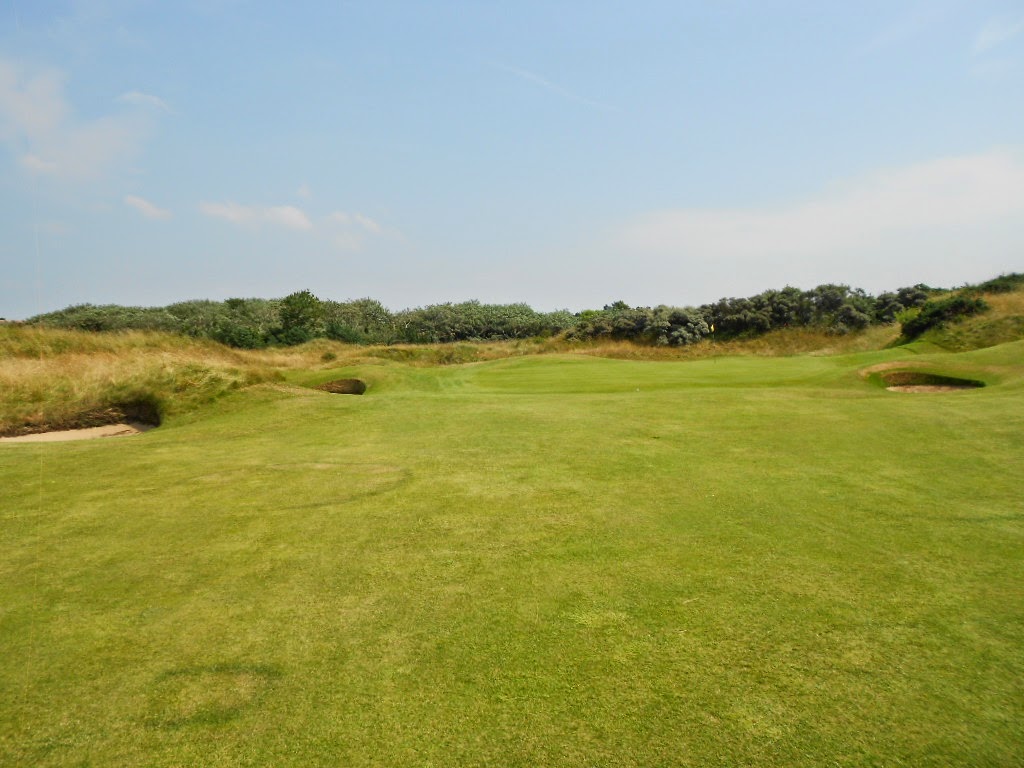 |
| A look into the 3rd green from 70 yards out. |
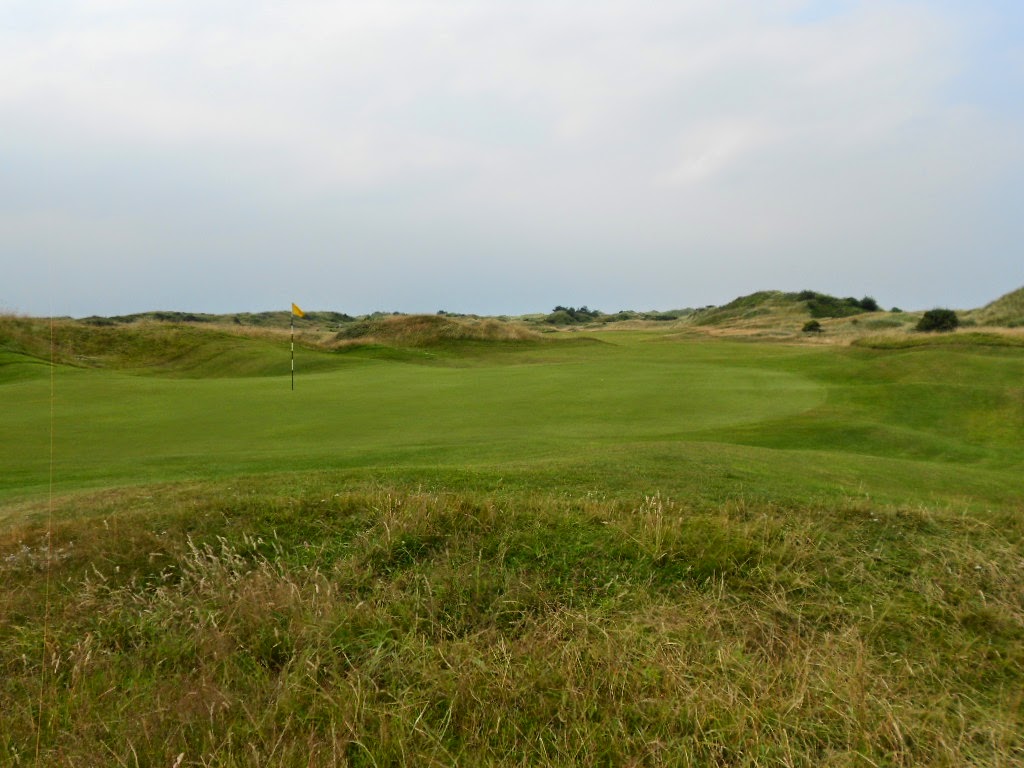 |
| A close look at the 3rd green from just off the back right. |
The fourth hole is the first (and longest) par 3 on the course and plays to 179 yards from the yellow tees and 200 from the back white tees. It is protected by a small bunkers on the left and right side of the green, as well as two very large bunkers on the front left. There is some extra space behind the green in case you hit your ball too long.
 |
| A look into the green from the 4th tee box. |
On the walk from the fourth green to the fifth tee box, you get to walk past a piece of history - the original proshop from 1897. It has several plaques that tell the story, and adds a neat touch to the round.
 |
| The original pro shop used in 1897. |
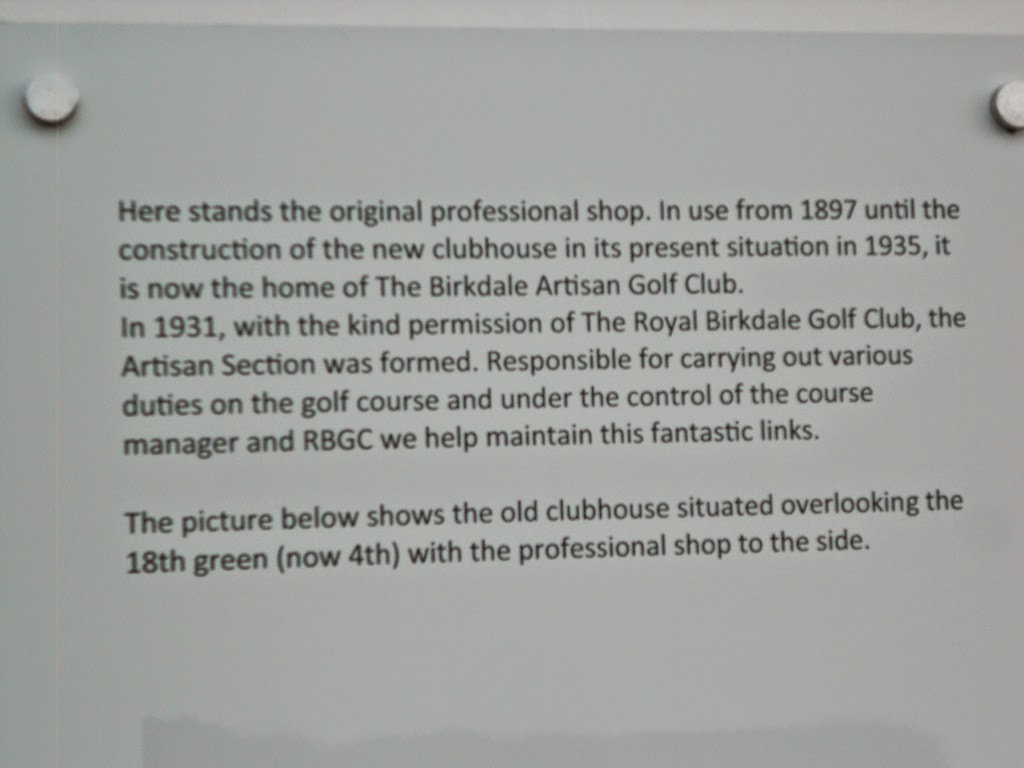 |
| A history of the building in the photo above. |
 |
| A look down the fairway from the 5th tee box. |
The fifth hole is a short par four, playing 316 yard. It has a slight dogleg right and a long green which is well protected by strategically placed bunkers. The green slopes from back to front with difficult mounds to read.
 |
| A look onto the 5th green from 100 yards out. |
 |
| A view of the dunes that hold the ocean at bay. |
To the right of the sixth tee is a large hill. If you climb to the top of it, you can see the very large dunes that protect the course from the ocean.
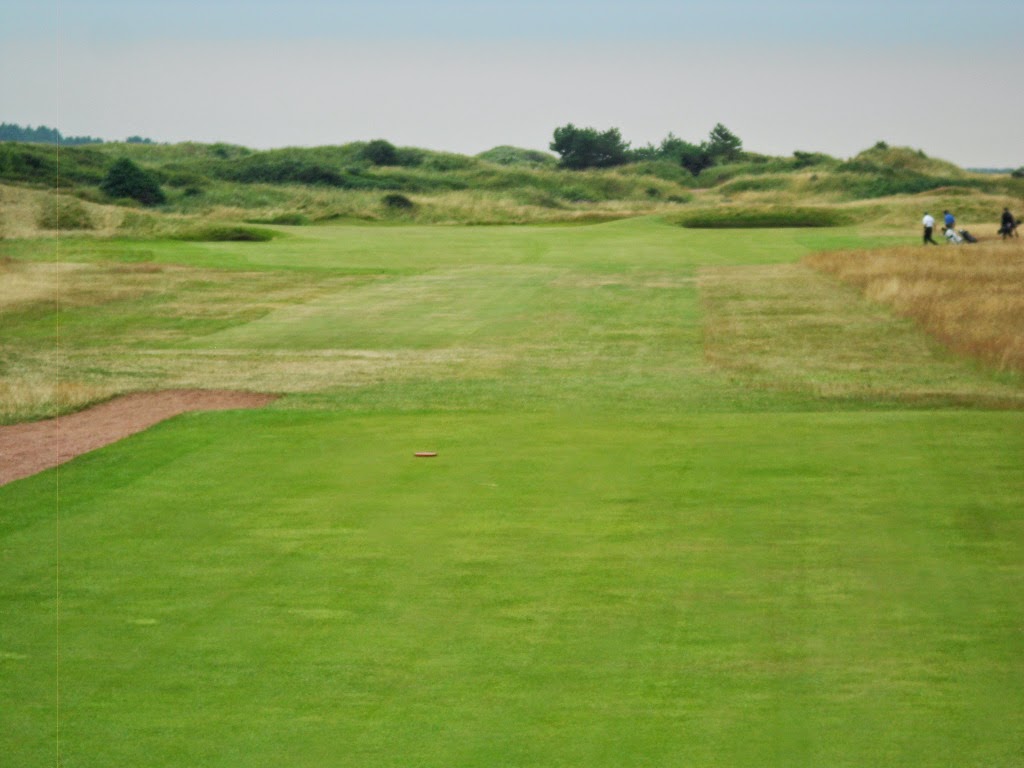 |
| A look down the fairway from the 6th tee box. |
The sixth hole is a par 5 that plays to 475 yards. The drive must avoid the bunkers on each side of the fairway. The hole requires a long second shot to an elevated green protected by bunkers to the front and surrounded by dunes. The green is large and well contoured with various difficult pin positions.
 |
| A look onto the 6th green from 75 yards out. |
 |
| A look out to the dunes and the ocean from the 7th tee box. |
From the elevated seventh tee box, you again get a good view of the dunes. This is also the first time on the course I was able to see the ocean (photo below).
 |
| A look out to the dunes and the ocean from the 7th tee box. |
The seventh hole is a par 3 that plays to 140 yards. It requires a solid shot over some rough to an upturned saucer shaped green closely protected by pot bunkers.
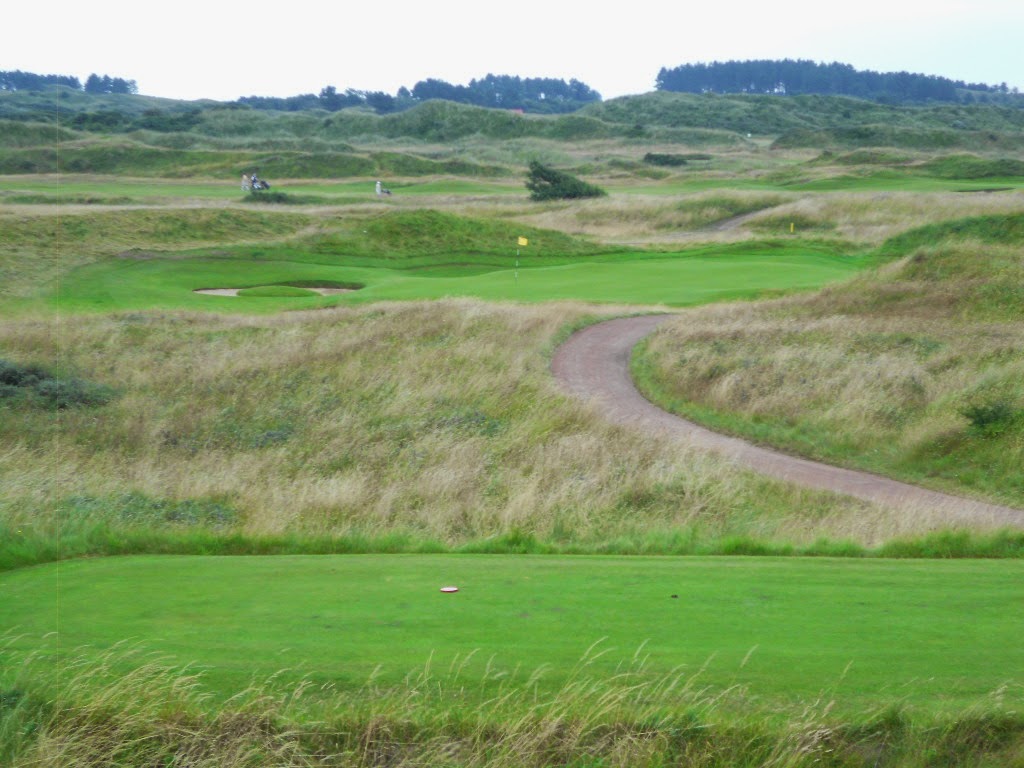 |
| A look into the green from the 7th tee box. |
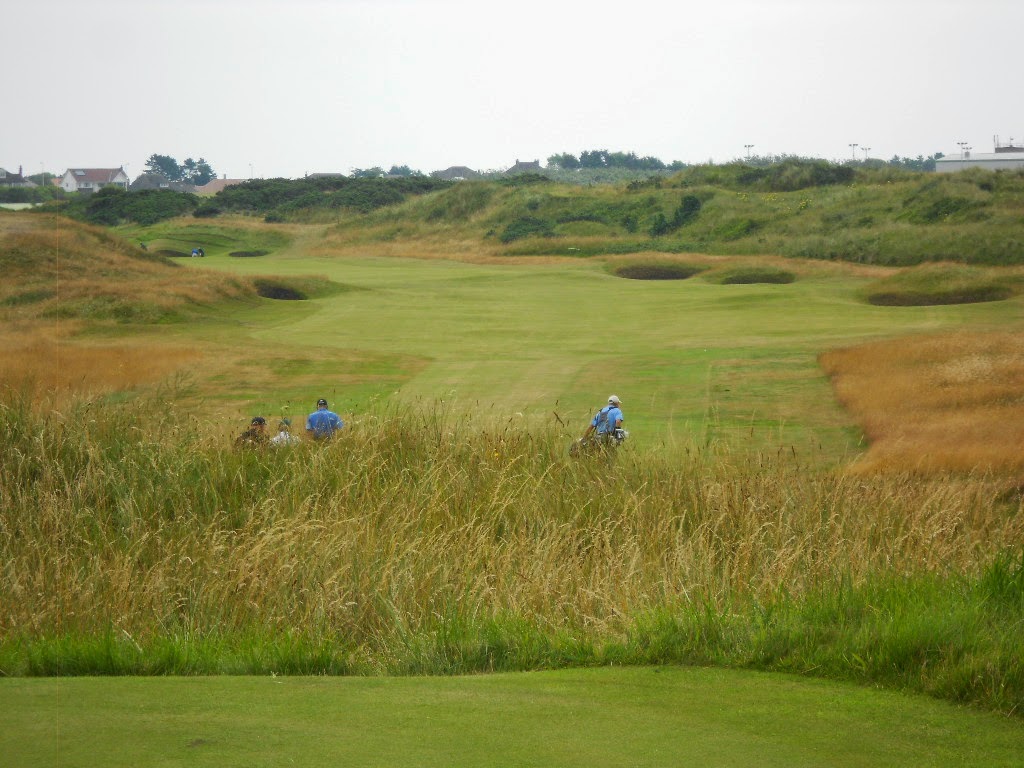 |
| A look down the fairway from the 8th tee box. |
The eighth hole is a par 4 that plays to 392 yards. The bunkers flanking the fairway demand a very accurate drive, then the second shot is played to quite a large green protected by deep bunkers. The putting surface has some very deceptive slopes.
 |
| A look into the 8th green from 100 yards out. |
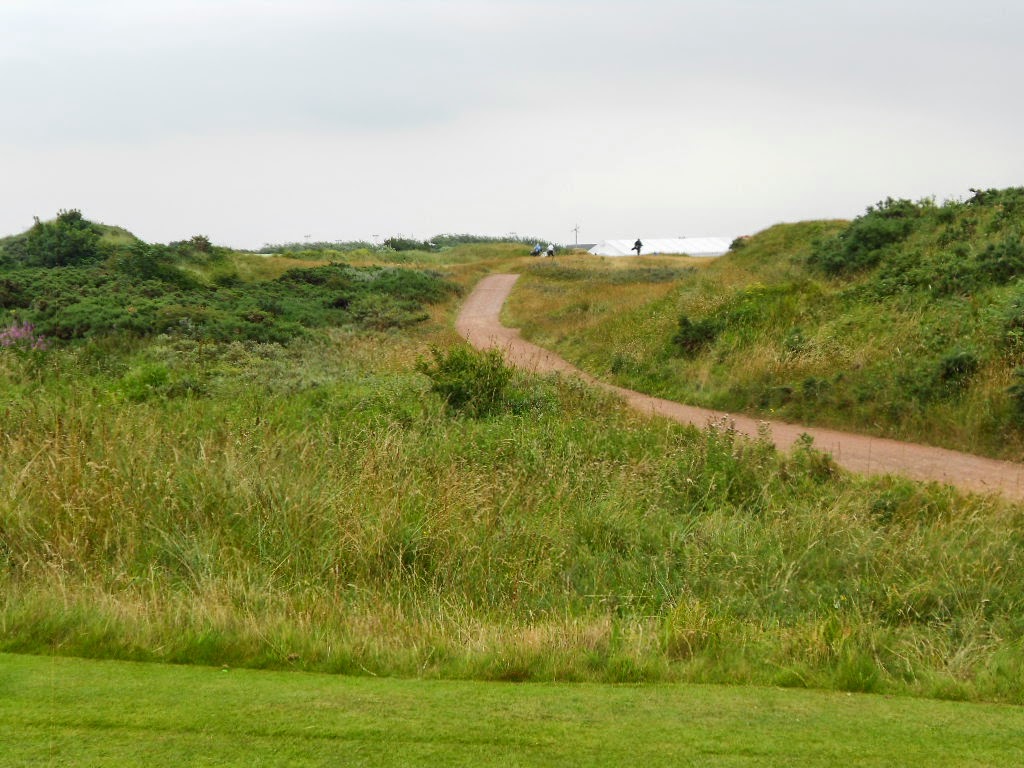 |
| A look down the fairway from the 9th tee box. |
 |
| A look down the fairway from the ladder next to the 9th tee box. |
The ninth hole is a par 4 that plays to 395 yards. The blind tee shot needs to be placed correctly (to the right of the walking path) to find the fairway. The green is slightly elevated making club selection important. Anything short will be gathered by the bunkers at the front and there is lots of trouble over the back.
 |
| A look into the 9th green from 140 yards out. |
 |
| A look down the fairway from the 10th tee box. |
The 10th hole is a 366 yard par 4. The fairway bunkering requires a well placed drive to open up the green to this relatively short par four.
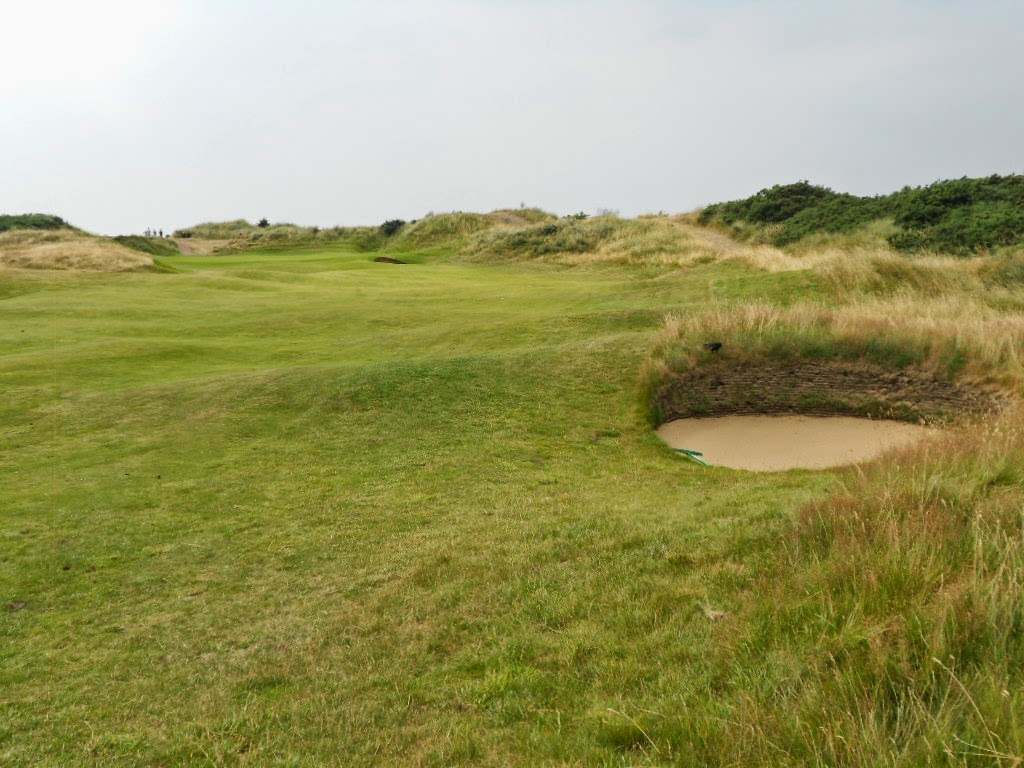 |
| A look into the 10th green from 130 yards out. |
 |
| A look down the fairway from the 11th tee box. |
The 11th hole is another short par 4 playing to 352 yards from the yellow tees. This hole demands accuracy from the tee and for the second shot. The elevated tee gives the impression you can let loose and rip a long drive. However, it is an optical illusion and a 5 wood or the equivalent is probably a better play off the tee here. The green is well contoured and the pin position makes the landing area on the green quite small.
 |
| A look into the 11th green from 80 yards out. |
The 12th is a 159 yard par 3. Deep bunkers and banks of rough grass protect the target. With the wind and the slope that runs away from the green, this can be a very difficult hole to par.
 |
| A look into the green from the 12th tee box. |
 |
| A look down the fairway from the 13th tee box. |
The 13th hole is a 422 yard par 4. This is a testing hole made difficult by the bunkering at drive length for moderate and long hitters. It requires a long and accurate tee shot to allow a second shot to reach the green with its background of tall sand hills.
 |
| A look into the 13th green from 120 yards out. |
The 14th hole is a 167 yard par 3. This is the last of the par 3s on the course, played from an elevated tee which is protected from the prevailing wind. The area surrounding the green has several deep bunkers waiting to collect any misdirected shot.
 |
| A look into the green from the 14th tee box. |
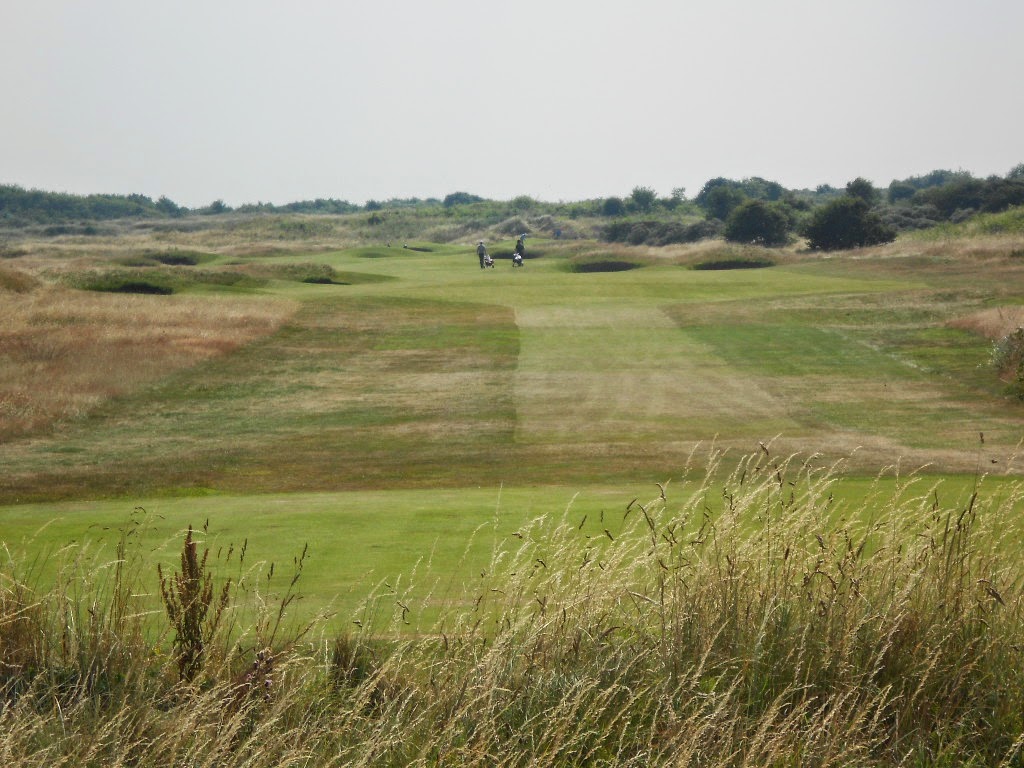 |
| A look down the fairway from the 15th tee box. |
The 15th hole is the start of three par 5s that complete the final four holes. It plays to 499 yards from the yellow tees. It is also one of the longest holes on the course. There are 15 bunkers to be negotiated on this long narrow hole.
 |
| A look into the 15th green from 150 yards out. |
The green slopes right to left and has a few severe slopes that can only be seen if looking from the back to the front. There are also bunkers that guard the front left and right of the green (photos below).
 |
| A look into the 15th green from 60 yards out. |
 |
| One of the bunkers guarding the 15th green. |
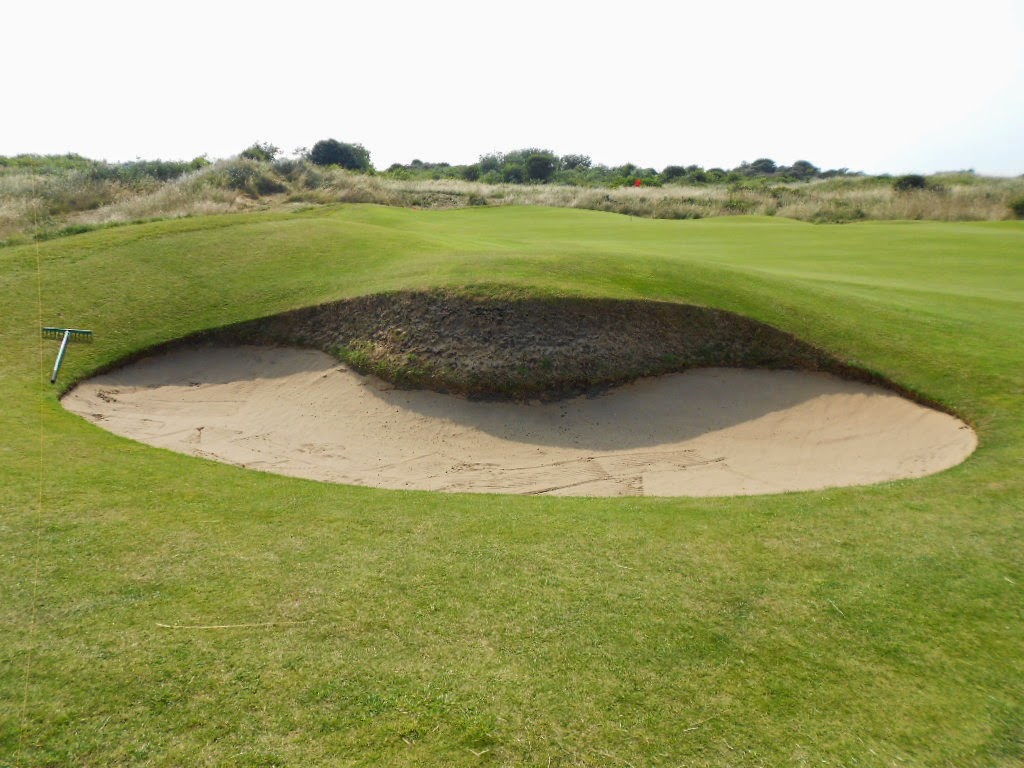 |
| Another bunker guarding the 15th green. |
 |
| A look down the fairway from the 16th tee box. |
The 16th is a 358 yard par 4. This hole demands a long carry over some very rough ground. The second shot is played to an elevated green that is well protected by very deep bunkers and hollows.
 |
| A look into the 16th green from 100 yards out. |
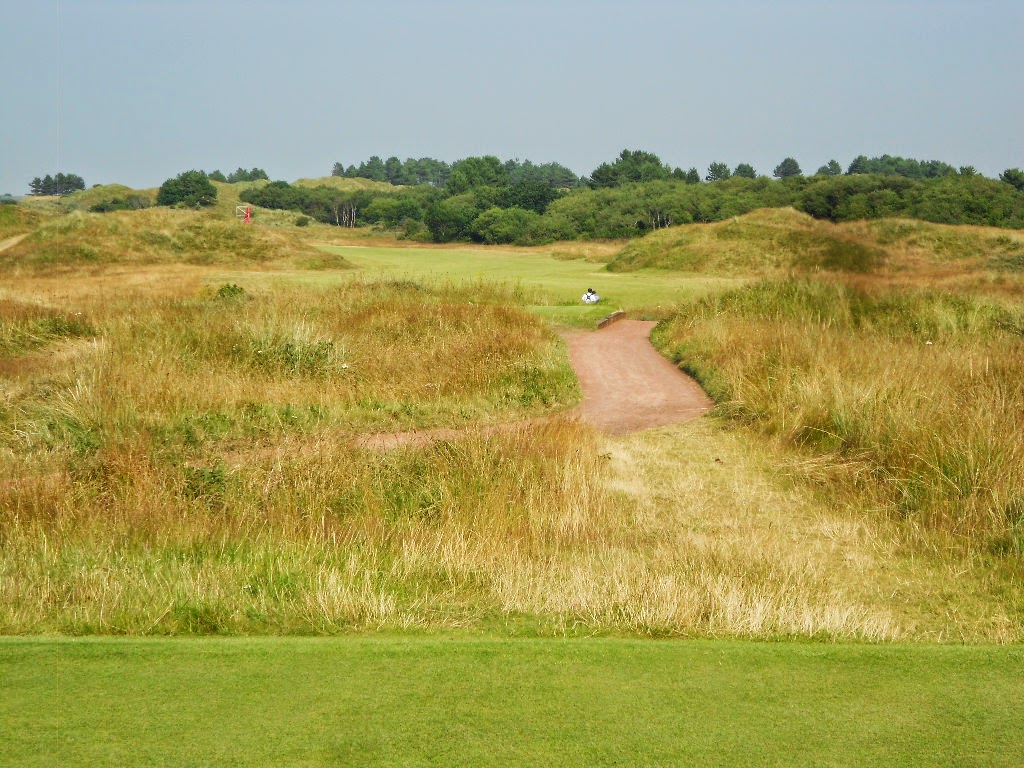 |
| A look down the fairway from the 17th tee box. |
The 17th is a 509 yard par 5. Drives have to be hit between two large sand dunes avoiding the two bunkers on the right of the fairway. With the firm ground here, the straight drive will normally get some run, shortening the hole. The two tier green is well protected by some severe bunkers and dramatic contouring.
 |
| A look into the 17th green from 75 yards out |
 |
| A look onto the 17th green from just off the right side. |
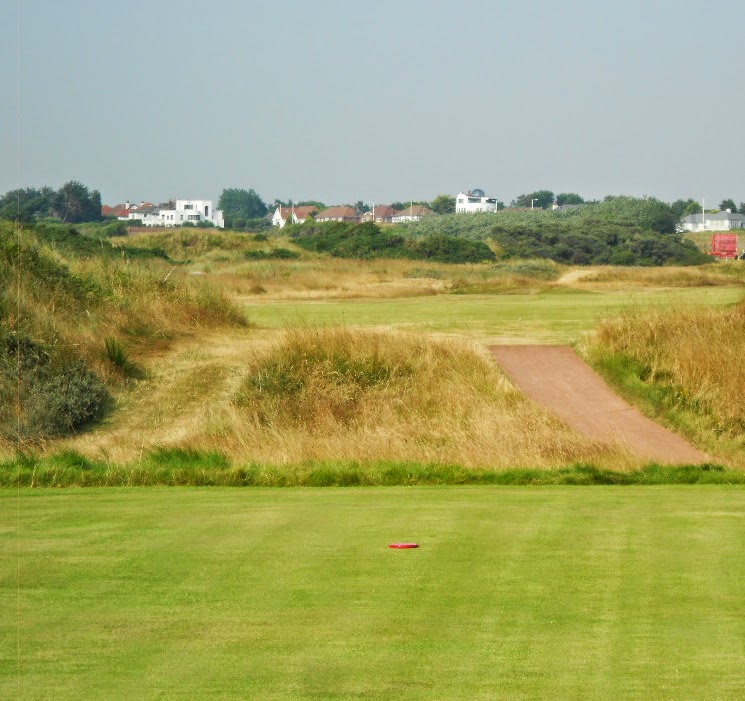 |
| A look down the fairway from the 18th tee box. |
The 18th hole is a par 5 that plays to 465 yards. Care should be taken to avoid the Out Of Bounds to the right of the tee. A long second shot to a well bunkered green, with the unique clubhouse in the background, helps to finish off a pretty awesome round of golf at one of the world's better courses.
 |
| A look into the 18th green from 75 yards out. |
 |
| Me standing on the edge of the 18th green in front of the iconic clubhouse. |
To say my round at Royal Birkdale was a challenge is an understatement. I lost 6-7 balls, I picked my ball up out of the rough twice, and I shot my highest round of any of the courses I played in England. However, it was a once in a lifetime experience at one of the best courses in the world and it was set to some of the toughest conditions a golfer can face. I would like to return some day and give the course a try when the weather is good with little to no wind. However, this round was a cherished memory I will never forget and I highly recommend it to anyone who finds themselves in Liverpool or Manchester and can secure a tee time.

